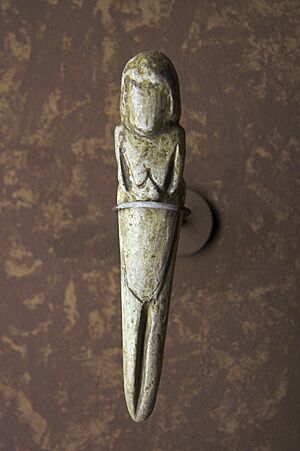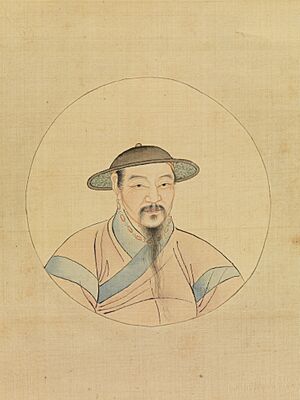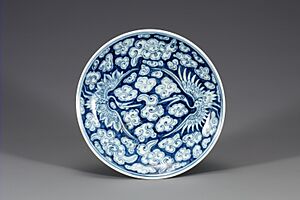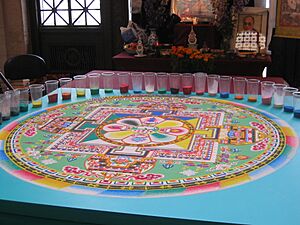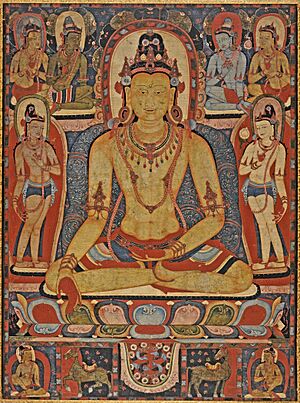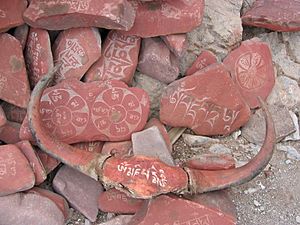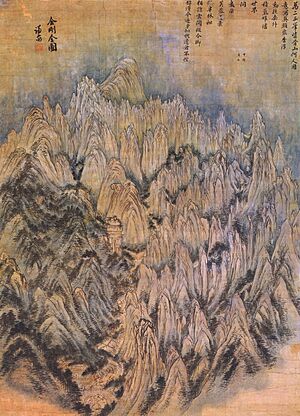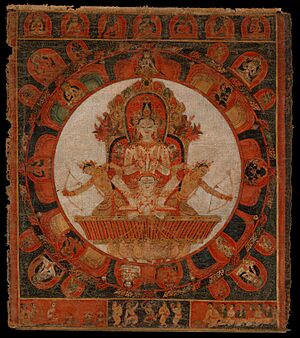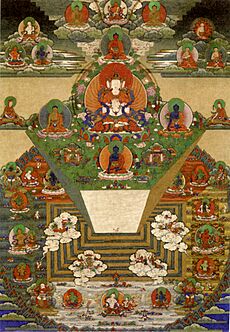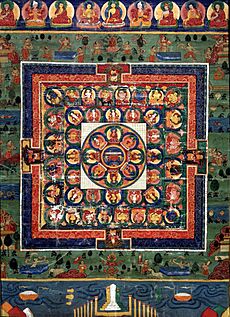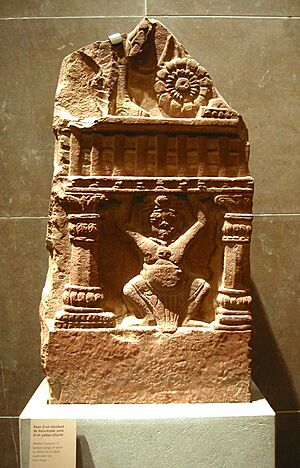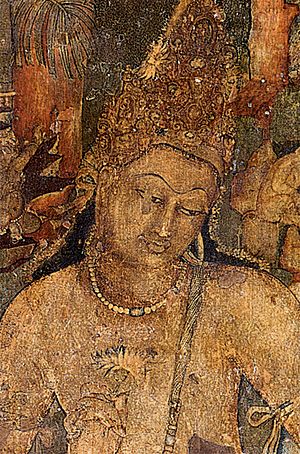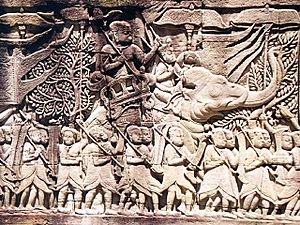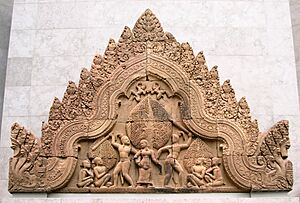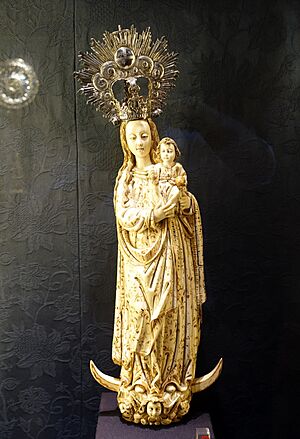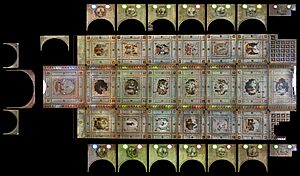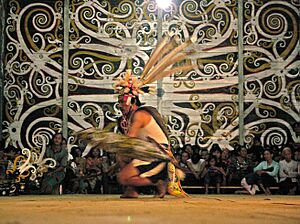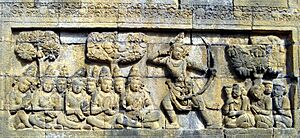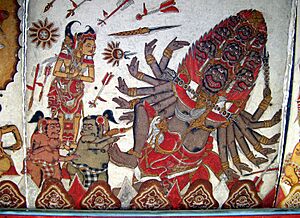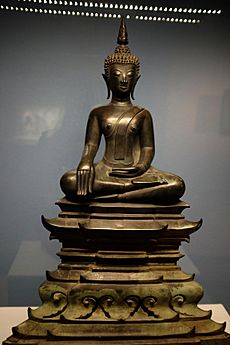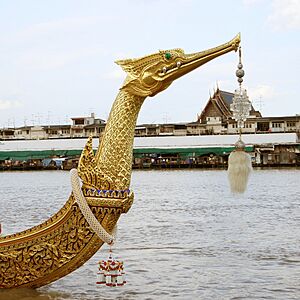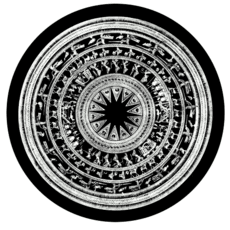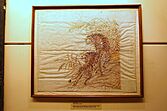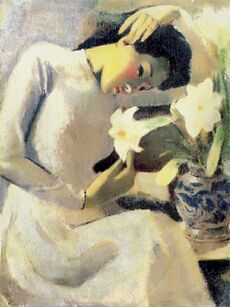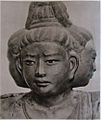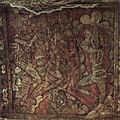History of Asian art facts for kids
The history of Asian art is super diverse! It includes many different types of art from cultures, places, and religions all over Asia. Asia is a huge continent with regions like Central, East, South, Southeast, and West Asia. Each region has its own special art styles.
For example, Central Asian art often comes from the Turkic people. East Asian art includes amazing works from China, Japan, and Korea. South Asian art covers the Indian subcontinent. Southeast Asian art comes from countries like Indonesia, Thailand, and Vietnam. West Asian art includes ancient art from Mesopotamia and later, lots of Islamic art.
Asian art has developed in ways similar to Western art. In fact, art from Asia and Europe have always influenced each other! Ideas and styles traveled along routes like the Silk Road. Later, during the Age of Discovery and colonization, cultures mixed even more. Today, the internet helps art from all over the world connect.
Besides very old prehistoric art, the art from Mesopotamia is some of the oldest in Asia.
Contents
Ancient Art in Northeast Asia
People first lived in the cold parts of Northeast Asia about 40,000 years ago. Around 21,000 BCE, two main cultures grew there: the Mal'ta culture and the Afontova Gora-Oshurkovo culture.
The Mal'ta culture, located near Lake Baikal in Siberia, made some of the first art from the Upper Paleolithic period. They created small statues called Venus figurines of Mal'ta. These figures are often made from mammoth ivory and are about 23,000 years old. Many show stylized clothes and faces. Some people think the Mal'ta culture might have been connected to European cultures at that time because similar figures were found there.
Art from Central Asia
Art in Central Asia comes from the Turkic people in countries like Kyrgyzstan, Kazakhstan, and Uzbekistan. In more recent times, Islamic art has greatly influenced this region. Before that, Central Asian art was shaped by Chinese, Greek, and Persian art, often through the Silk Road.
Nomadic Folk Art
Nomadic folk art is a very important part of Central Asian art. This art shows the way of life for nomadic groups who moved around the region. You can see beautiful items like embroidered carpets, carved doors, and objects made with semi-precious stones.
Music and Instruments
Central Asia has a rich history of classical music and instruments. Some famous musical instruments, like the Rubab, Dombra, and Chang, came from this region.
Bringing Central Asian Art Back
The people of Central Asia often lived a nomadic life. Because of this, much of their modern art is inspired by this old way of living. This traditional and cultural touch makes Central Asian art very popular at international art shows. This global attention has really helped show the world how valuable Central Asian art is.
Art from East Asia
Chinese Art
Chinese art has changed a lot throughout its long history. It was often divided into periods based on the ruling dynasties and new technologies. Important thinkers, religious leaders, and even political leaders influenced different art forms. Chinese art includes fine arts, folk arts, and performance arts. It's any art from China or by Chinese artists, old or new.
During the Song dynasty, a type of poetry called Ci (詞) became popular. It often expressed feelings of desire. Paintings from this time showed subtle landscapes with blurred outlines, giving a sense of distance. Art focused more on spiritual feelings than strong emotions. Kunqu, the oldest form of Chinese opera, also started in the Song dynasty. Later, in the Yuan dynasty, the painter Zhao Mengfu greatly influenced Chinese landscape painting.
Chinese Painting and Calligraphy
Chinese Painting Two main styles in Chinese painting are Gongbi and Xieyi.
- Gongbi means "meticulous." It uses rich colors and many details. It often shows portraits or tells stories.
- Xieyi means "freehand." This style is often exaggerated and not totally realistic. It focuses on showing the artist's feelings and is usually used for landscapes.
Besides paper and silk, traditional paintings were also done on walls, like in the Mogao Grottoes in Gansu Province. The Dunhuang Mogao Grottoes were built in the Northern Wei dynasty (386–534 AD). They have over 700 caves, with murals on the walls of 492 of them. That's over 45,000 square meters of paintings! The murals show many things, like Buddha statues, angels, and important historical events. Early paintings were influenced by India and the West. By the Tang dynasty (618–906 CE), the murals started to show a unique Chinese style. {{wide image|Along the River During the Qingming Festival (Qing Court Version).jpg|880px|Panorama of Along the River During the Qingming Festival, an 18th-century copy of a 12th-century painting. Notice how the scroll starts from the right.]]
Chinese Calligraphy
Chinese calligraphy, or beautiful writing, began with the Dazhuan script in the Zhou dynasty. When Emperor Qin unified China, his prime minister created the Xiaozhuan (small seal) style as the official writing. It was elegant but slow to write. In the Eastern Han dynasty, Lishu (Official Script) became popular. It was faster because it had fewer curves. Later, the Kaishu style (regular script) appeared. It's simpler and neater, and it's still used a lot today.
Ancient Chinese Crafts
Jade Early jade was used for ornaments or special religious ceremonies. The first carved jade in China appeared in the Neolithic period (about 3500–2000 BCE). During the Shang dynasty (c. 1600–1046 BCE), special jade objects like Bi (circular with a hole) and Cong (square tubes) were made. People believe these were used in sacrifices and represented the sky and earth. In the Zhou dynasty (1046–256 BCE), better tools allowed for more detailed jade carvings. Jade was then used for pendants and clothing ornaments. People thought jade was immortal and could protect its owner, so jade objects were often buried with the dead.
Porcelain Porcelain is a type of ceramic made from a special clay called kaolin, baked at very high temperatures. The first ceramics in China appeared in the Shang dynasty (c.1600–1046 BCE). This led to the invention of porcelain. Chinese porcelain dates back to the Han dynasty (206 BC – 220 AD). In the Tang dynasty, there were two main types: celadon (greenish) and white porcelain. In the Song dynasty, Jingdezhen became the main place for making royal porcelain, and blue and white porcelain began to be produced there.
Modern Chinese Art
After the last dynasty in China ended, Chinese artists started to be influenced by Western art. They began to mix Western styles with Chinese culture. For example, Chinese composer Li Jinhui, known as the father of Chinese pop music, was inspired by American jazz and created popular music that became a huge hit. In the early 20th century, oil paintings came to China. More Chinese painters started using Western painting techniques and combining them with traditional Chinese art. Comics also became popular and were an affordable way for many people to be entertained.
Tibetan Art
Tibetan art is mainly sacred art, deeply connected to Tibetan Buddhism. The Sand Mandala (kilkhor) is a Tibetan Buddhist tradition. It shows that everything in the world is temporary. Once a sand mandala is built and its ceremonies are done, it is carefully destroyed. This teaches that material things don't last forever.
Tibetan Buddhism has many bodhisattvas, who are compassionate beings. They choose not to go to Nirvana so they can help others. One common bodhisattva in Tibetan art is Chenrezig (Avalokitesvara). He is often shown with a thousand arms and an eye in each hand. This represents his ability to see and hear everyone's requests.
Much of Tibetan Buddhist art is part of a practice called Vajrayana. This practice uses many visualizations during meditation. The detailed tantric art helps with these visualizations. This includes statues of meditation deities and mandalas.
Tantric Buddhism also shows wrathful deities. These figures have angry faces and are surrounded by flames or skulls. But their scary look hides their true compassionate nature. They represent protectors of the Buddhist teachings and help followers overcome negative thoughts.
Chinese painting greatly influenced Tibetan painting. From the 14th and 15th centuries, Tibetan art started to include many Chinese elements. By the 18th century, Chinese painting had a very strong impact on Tibetan visual art.
Japanese Art
Japanese art and architecture include works made in Japan from ancient times (around 10,000 BC) to today. It covers many styles and materials. These include old pottery, wood and bronze sculptures, ink paintings on silk, and many other types of art.
A popular art form called Ukiyo-e became famous in Edo (modern-day Tokyo) in the late 1600s. It started with single-color prints by Hishikawa Moronobu. At first, only ink was used, but later, artists added color by hand. In the 1700s, Suzuki Harunobu developed a way to print in many colors, creating nishiki-e.
Japanese painting (Kaiga) is one of the oldest and most refined Japanese arts. It includes many styles. Japanese painting has a long history of mixing traditional Japanese ideas with ideas brought from other places.
The first paintings in Japan go back to prehistoric times. Simple stick figures and geometric designs are found on Jōmon period pottery. Mural paintings with designs of shapes and figures have been found in tombs from the Kofun period (300–700 AD).
Ancient Japanese sculpture was mostly linked to Buddhist idol worship or Shinto rituals. Sculpture, more than other arts, became very focused on Buddhism. Artists traditionally used metal, especially bronze, and more commonly, wood. These sculptures were often lacquered, gilded, or brightly painted.
Ukiyo, meaning "floating world," refers to the lively culture that grew in cities like Edo, Osaka, and Kyoto. It was a playful reference to the Buddhist idea of a "Sorrowful World," which is the earthly world of death and rebirth.
Korean Art
Korean art is known for its traditions in pottery, music, calligraphy, painting, and sculpture. It often uses bold colors, natural shapes, precise forms, and surface decorations.
While Korean, Chinese, and Japanese cultures are distinct, their arts share many historical similarities and have influenced each other.
Studying Korean art is still growing in the West. For a long time, Korea was seen as just a bridge for Chinese culture to reach Japan. However, scholars now recognize Korea's unique art and its important role in not only passing on Chinese culture but also making it its own. As they say, "An art given birth to and developed by a nation is its own art."
The history of Korean painting dates back to around 108 CE. Until the Joseon dynasty, Chinese painting was the main influence. However, Korean artists used Korean landscapes, facial features, and Buddhist themes. They also focused on observing the sky, which fit with Korea's fast progress in astronomy.
Throughout Korean painting history, there's been a clear difference between:
- Monochromatic works: Black brushwork on mulberry paper or silk. Scholars often preferred these, believing you could "see" color in the shades of black.
- Colorful folk art: Also called min-hwa, ritual arts, tomb paintings, and festival arts. These used lots of color.
This difference was often based on social class. Scholars felt that using actual color made paintings less refined. But Korean folk art and architectural paintings used bright colors to decorate buildings, inspired by Chinese architecture and early Buddhist art from India.
Contemporary art in Korea: The first Western-style oil painting in Korea was seen in the self-portraits of artist Ko Hu i-dong (1886–1965). Only three of these works still exist today.
Korean pottery was made as early as 6000 BCE. This pottery is sometimes called comb-patterned pottery because of the decorative lines carved on it. Early Korean societies relied on fishing, so they used pottery to store fish and shellfish. Pottery from the East coast often had a flat base, while pottery from the South coast had a round base.
Art from South Asia
Pakistani Art
Pakistani art has a long history and many different forms. These include painting, sculpture, calligraphy, pottery, and textile arts like woven silk. Geographically, it's part of the art of the Indian subcontinent.
Buddhist Art
Buddhist art began in India after the Buddha lived, around the 6th to 5th century BCE. It then spread across Asia and changed as it met new cultures. As Buddhism spread, its art traveled with believers. It went north through Central Asia into East Asia, forming the Northern branch of Buddhist art. It also went east into Southeast Asia, forming the Southern branch. In India, Buddhist art thrived and even influenced Hindu art.
A common symbol in Buddhist art is the mandala. From a viewer's perspective, it's like a map of the perfect universe. Mandalas are used to help people focus during meditation. They can also create a sacred space and help meditators feel a sense of oneness with the universe. The famous psychologist Carl Jung saw the mandala as a symbol of the inner self. He believed drawing mandalas helped him understand emotions and work towards inner peace.
Bhutanese Art
Bhutanese art is very similar to the art of Tibet. Both are based on Vajrayana Buddhism and feature many divine beings.
The main types of Buddhism in Bhutan are Drukpa Kagyu and Nyingma. Drukpa Kagyu is known for paintings that show the history of Buddhist masters. The Nyingma order is known for images of Padmasambhava, who brought Buddhism to Bhutan in the 7th century.
Each divine being in Bhutanese art has special shapes, colors, or objects, like a lotus or a thunderbolt. All sacred images are made exactly as they have been for centuries.
Bhutanese art is rich in bronze sculptures, known as Kham-so. Even though they are made in Bhutan, the technique came from the Kham province in Tibet. Wall paintings and sculptures in Bhutan follow the old ideals of Buddhist art. Artists had more freedom when creating images of demons than when making images of divine beings.
The arts and crafts of Bhutan are called Zorig Chosum, meaning the "thirteen arts and crafts of Bhutan." These include carpentry, painting, paper making, blacksmithing, weaving, and sculpting. The Institute of Zorig Chosum in Thimphu teaches these traditional arts to preserve Bhutan's rich culture. There's also a 'Voluntary Artists Studio' to encourage young artists.
Indian Art
Indian art can be sorted into different time periods, each showing religious, political, and cultural changes. The oldest examples are rock carvings called petroglyphs, some from before 5500 BC.
The art of the Indus Valley Civilization came next. Later, there were carved pillars at Ellora and frescoes (wall paintings) at Ajanta and Ellora Caves.
The Mughal Empire added a lot to Indian art, including Mughal painting. This was a style of miniature painting heavily influenced by Persian art. Mughal architecture also became famous.
During the British Raj (British rule), modern Indian painting developed by mixing traditional Indian and European styles. Raja Ravi Varma was a pioneer of this time. The Bengal School of Art also grew during this period.
One very popular art form in India is called Rangoli. It's a decoration made using finely ground white powder and colors, often drawn outside homes.
Indian visual arts (sculpture, painting, and architecture) are closely linked to non-visual arts like music and dance. They all share the same spiritual beliefs and ways of showing symbols and spiritual states. To truly understand Indian art, it helps to know about its philosophy, culture, society, religion, and politics.
Important periods in Indian art include:
- Ancient period (Hinduism, Jainism, Buddhism)
- Islamic influence
- Colonial period (British rule)
- Modern and Postmodern art
- After India gained independence (Post-1947)
Nepalese Art
The ancient and rich traditional culture of Kathmandu, and all of Nepal, is a unique blend of Hindu and Buddhist beliefs. It also includes the cultural diversity of other religions like Jainism, Islam, and Christianity.
Art from Southeast Asia
Bruneian Art
Silver is a popular material in Bruneian art. Silversmiths create ornaments, flower vases, and gongs (metal disks that make a resonant sound when struck). Another popular item is pasigupan, a small pot with a mandala print used for tobacco.
Weaving skills have been passed down through generations in Brunei. They produce fabric for gowns and sarongs. Weaving became important in the 15th century. A traveler named Antonio Pigafetta visited Brunei and saw how clothes were made. One example is a Jongsarat, a handmade garment used for weddings and special events. It often has silver and gold threads and can also be used as a wall hanging.
The two main types of clothing in Brunei are Batik and Ikat. Batik is cotton cloth dyed using a wax-resist technique to create patterns. Ikat is made similarly, but the pattern is created by dyeing the threads before weaving the cloth.
Cambodian Art
Cambodian art and culture have a rich history, heavily influenced by India. In return, Cambodia also influenced Thailand and Laos. Religion has been a major source of inspiration for Cambodian art for nearly two thousand years. Cambodians developed a unique Khmer belief system by mixing their own ancient beliefs with Indian religions like Buddhism and Hinduism. Indian culture, including its language and arts, reached Southeast Asia around the 1st century CE. It's thought that traders brought Indian customs while trading with China.
The visual arts of Cambodia go back centuries to ancient crafts. Khmer art was at its best during the Angkor period. Traditional Cambodian arts include textiles, weaving, silversmithing, stone carving, lacquerware, ceramics, temple murals, and kite-making. In the mid-20th century, modern art began in Cambodia. However, both traditional and modern arts declined later in the 20th century, partly because artists were killed by the Khmer Rouge. Now, the country is seeing an artistic revival with more support from governments, groups, and tourists.
Khmer Sculpture
Khmer sculpture refers to the stone carvings of the Khmer Empire, which ruled a large area (including modern Cambodia) from the 9th to the 13th century. The most famous examples are found in Angkor, the empire's capital.
By the 7th century, Khmer sculpture started to move away from its Indian influences. Through constant changes in style, it developed its own unique look, which was fully formed by the 10th century. Khmer sculpture went beyond just religious figures. It often showed court figures dressed as gods and goddesses. It also became a way for artists to show off their skill and create perfect styles.
The gods in Khmer sculpture are from India's two great religions, Buddhism and Hinduism. They are always shown very accurately, meaning skilled priests likely oversaw the work. However, unlike some Indian images that repeat an ideal type, these images are very realistic. They show living models: the king and his court. The true purpose of Khmer art was to glorify the rich and powerful by showing them as gods. The people were meant to see this as proof of the ruler's divinity. The rich enjoyed seeing themselves, in an idealized way, immortalized with beautiful decorations, elegant clothes, and fancy jewelry.
These sculptures are amazing images of gods, looking royal and powerful, but also with a feminine beauty. They make us think of important people in the royal courts. The artists who carved these stones surely met the demands of those who paid for them. The sculptures show the chosen god in the correct way and skillfully portray high-ranking court figures in all their splendor, with their sophisticated beauty, clothing, and jewelry.
Filipino Art
The oldest known Filipino art is rock art, like the Angono Petroglyphs, made between 6000 and 2000 BC. These carvings might have been used for healing sick children. Other rock arts include charcoal drawings and red hematite art. Between 890 and 710 BC, the Manunggul Jar was made in Palawan. It was a burial jar, and its lid shows a boat carrying a soul to the afterlife. Around 100 BC, the Kabayan Mummy Burial Caves were carved. Between 5 BC and 225 AD, the Maitum anthropomorphic pottery was created. These were burial jars shaped like human heads, hands, and feet.
By the 4th century AD, ancient Filipinos were building giant warships. The oldest evidence of these ships, called balangay, was found in Butuan and dates to 320 AD. The oldest artifact with writing on it is the Laguna Copperplate Inscription from 900 AD, which talks about paying a debt. The Butuan Ivory Seal (9th-12th century AD) is the oldest ivory art with ancient script. During this time, the Agusan image, a gold statue of a deity, was also made, possibly influenced by Hinduism and Buddhism.
From the 12th to 15th century, the Butuan Silver Paleograph was created, but its writing is still a mystery. Between the 13th–14th century, the Banton cloth was made, the oldest surviving ikat textile in Southeast Asia. It was used as a death blanket. By the 16th century, Spanish colonization began to influence many art forms in the Philippines.
From 1565 to 1815, Filipino craftspeople built the Manila galleons, large ships used for trade between Asia and the Americas. In 1565, the ancient tradition of tattooing was first recorded. Fort San Antonio Abad was finished in 1584, and Fort Santiago in 1591. By 1600, the Rice Terraces of the Philippine Cordilleras were made. Five clusters of these terraces are now World Heritage Sites. The San Agustin Church in Manila, a World Heritage Site, was built in 1607 and is famous for its painted interior.
In 1613, the oldest surviving suyat writing on paper was found. The Monreal Stones were created in 1621. The Arch of the Centuries was made in 1680. In 1692, the painting Nuestra Senora de la Soledad de Porta Vaga was created.
Manaoag Church was established in 1701. The Paoay Church, a World Heritage Site known for its giant buttresses (supports), was built in 1710. Religious paintings were made in Santa Ana in 1720. The historical Santa Ana Church was built in 1725. The Santa Maria Church, a World Heritage Site known for its highland structure, was built in 1765. Bacarra Church was built in 1782. In 1783, the idjangs, castle-fortresses in Batanes, were first recorded. The Miagao Church, a World Heritage Site famous for its facade carvings, was built in 1797.
In 1807, the Basi Revolt paintings showed the Ilocano revolution against Spanish rules on basi (a local wine) production. Paco Park was established in 1822. In 1824, the Las Piñas Bamboo Organ, the first and only organ made of bamboo, was created. By 1852, the Sacred Art paintings of the Parish Church of Santiago Apostol were finished. In 1884, two paintings, Assassination of Governor Bustamante and His Son and Spoliarium, won awards in Spain. Feeding the Chicken was painted in 1890. The Parisian Life was painted in 1892, and La Bulaqueña in 1895. The clay sculpture The Triumph of Science over Death was made in 1890. The San Sebastian Church in Manila, the first and only all-steel church in Asia, was built in 1891. In 1894, the clay art Mother's Revenge was made.
In the 20th century, the Koran of Bayang was written. The Rizal Monument was completed in 1913. The University of Santo Tomas Main Building was rebuilt in 1927. The Manila Metropolitan Theater was built in 1931. The Progress of Medicine in the Philippines paintings were finished in 1953. The Santo Domingo Church was built in 1954. In 1962, the International Rice Research Institute painting was completed. The Bonifacio Monument was created in 1993.
Indonesian Art
Indonesian art and culture have been shaped by a long history of mixing local customs with many foreign influences. Indonesia is located on old trading routes between the Far East and the Middle East. This led to many cultural practices being strongly influenced by religions like Hinduism, Buddhism, Confucianism, and Islam. The result is a complex mix of cultures, very different from the original local traditions.
Indonesia is not usually known for paintings, except for the detailed and expressive Balinese paintings. These often show natural scenes and themes from traditional dances.
Other unique paintings include those by the Kenyah people. Their designs are based on local natural things like ferns, trees, dogs, hornbills, and human figures. You can still see these decorating the walls of Kenyah Dayak longhouses in East Kalimantan.
Indonesia has a long history of Bronze and Iron Ages. But art really grew from the 8th to the 10th century, both as standalone artworks and as parts of temples.
Most famous are the hundreds of meters of relief sculptures at the Borobudur temple in central Java. About two miles of beautiful relief sculptures tell the story of the Buddha's life and his teachings. The temple originally had 504 statues of the seated Buddha. This site, like others in central Java, clearly shows Indian influence.
Calligraphy, mostly based on the Qur'an, is often used as decoration because Islam sometimes discourages naturalistic pictures. Some foreign painters have also lived in Indonesia. Modern Indonesian painters use many different styles and themes.
Balinese Art
Balinese art comes from Hindu-Javanese origins. It grew from the work of artists from the Majapahit Kingdom when they expanded to Bali in the late 13th century. From the 16th to the 20th centuries, the village of Kamasan was the center of classical Balinese art. In the early 20th century, new kinds of Balinese art appeared. Since the late 20th century, Ubud and nearby villages became known as the center of Balinese art. Ubud and Batuan are famous for paintings, Mas for woodcarvings, Celuk for gold and silversmiths, and Batubulan for stone carvings.
In the 1920s, many Western artists came to Bali. It became a place for new artists, like Walter Spies and Rudolf Bonnet. Most of these Western artists didn't influence Balinese art much until after World War Two. However, some accounts overstate the Western presence and don't give enough credit to Balinese creativity.
This exciting period of art reached its peak in the late 1930s. Famous visitors, like Charlie Chaplin, encouraged local artists to create very original works. During their stay in Bali in the mid-1930s, anthropologists Gregory Bateson and Margaret Mead collected over 2000 paintings.
Spies and Bonnet are often credited with helping to modernize traditional Balinese paintings. From the 1950s onwards, Balinese artists started using ideas about perspective and anatomy from these artists. More importantly, they encouraged experiments and new ways of doing things. This led to a burst of individual expression and faster changes in Balinese art.
Lao Art
Laotian art includes ceramics, Buddhist sculptures, and music.
Lao Buddhist sculptures were made from many materials like gold, silver, and most often, bronze. Brick-and-mortar was also used for huge statues, like the famous Phya Vat in Vientiane. Wood is popular for small Buddhist images often left in caves. It's also common for large, life-size standing Buddha statues. The two most famous sculptures carved in semi-precious stone are the Phra Keo (Emerald Buddha) and the Phra Phuttha Butsavarat. The Phra Keo, made from a solid block of jade, was in Vientiane for 200 years before the Siamese took it. Today, it's a very important symbol for Thailand and is in Bangkok. The Phra Phuttha Butsavarat, a crystal image, is also in Bangkok.
Many beautiful Lao Buddhist sculptures are carved directly into the Pak Ou caves. These caves, near Luang Prabang, Laos, are only reachable by boat. They are known for their impressive Buddhist and Lao style sculptures carved into the cave walls. There are also hundreds of old Buddhist figures left on the floors and shelves by owners who didn't want to destroy them.
Malaysian Art
Malaysian art is mostly made up of Malay art and Bornean art. It shares similarities with other Southeast Asian styles, like those from Brunei and Indonesia. The history of art in Malaysia goes back to the Malay sultanates, with influences from Chinese, Indian, and Islamic arts.
Traditional Malaysian art mainly focuses on carving, weaving, and silversmithing. It ranges from handmade baskets from rural areas to the silverwork of the Malay courts. Common artworks include decorated kris (a type of dagger) and beetle nut sets. Luxurious textiles called Songket are made, as well as traditional patterned batik fabrics. Indigenous East Malaysians are known for their wooden masks. Malaysian art has only recently expanded because before the 1950s, Islamic rules against drawing people and animals were strong. Textiles like batik and songket are used for decorations, often embroidered with paintings or patterns. Traditional jewelry was made from gold and silver with gems. In East Malaysia, leather and beads were used for similar effects.
Myanmar Art
The art of Myanmar (Burma) was influenced by India and was often religious. This included Hindu sculptures and Theravada Buddhist images.
The Bagan period saw big developments in many art forms, from wall paintings and sculptures to stucco and wood carving. After a gap in surviving art from the 14th to 16th century, artists created paintings and sculptures that show Burmese culture. Burmese artists have faced government interference and censorship, which has made it harder for art to grow in Myanmar. Burmese art often shows Buddhist elements like the mudra (hand gestures), Jataka tales (stories of Buddha's past lives), pagodas, and Bodhisattvas.
Singaporean Art
The history of Singaporean art includes local art traditions from the Malay Archipelago. It also includes the diverse art practices of artists and migrants from China, India, and Europe.
Singaporean art includes sculptures, textiles, and decorative arts from the Malay world. It also has portraits, landscapes, sculptures, prints, and natural history drawings from the British colonial period. Later, Chinese-influenced Nanyang style paintings, social realist art, abstract art, and photography emerged after the war. Today, it includes modern art practices like performance art, conceptual art, installation art, video art, sound art, and new media art. The start of modern Singaporean art is often linked to the rise of art groups, schools, and exhibitions in the 20th century.
Today, contemporary art from Singapore is shown internationally at art biennales and other major exhibitions.
Thai Art
Traditional Thai art and visual art were mainly Buddhist and Royal Art. Sculptures were almost always of Buddha images. Paintings were used to illustrate books and decorate buildings, mostly palaces and temples. Thai Buddha images from different periods have unique styles. Modern Thai art often mixes traditional Thai elements with modern techniques.
Traditional Thai paintings showed subjects in two dimensions without perspective. The size of each element in the picture showed how important it was. The main way of arranging things was by dividing areas. This removed the middle ground, which would usually suggest perspective. Perspective was only introduced when Western influence arrived in the mid-19th century.
The most common stories for paintings were: the Jataka stories (about Buddha's past lives), events from the Buddha's life, Buddhist heavens and hells, and scenes of daily life.
The Sukhothai period began in the 14th century. Buddha images from this time are elegant, with flowing bodies and slender, oval faces. This style focused on the spiritual side of the Buddha, leaving out many small body details. This effect was made even better by casting images in metal rather than carving them. This period also saw the introduction of the "walking Buddha" pose.
Sukhothai artists tried to follow the traditional rules for how a Buddha should look, as described in ancient texts:
- Skin so smooth that dust can't stick to it.
- Legs like a deer.
- Thighs like a banyan tree.
- Shoulders as big as an elephant's head.
- Arms round like an elephant's trunk, long enough to touch the knees.
- Hands like lotus flowers about to bloom.
- Fingertips turned back like petals.
- Head like an egg.
- Hair like a scorpion's stingers.
- Chin like a mango stone.
- Nose like a parrot's beak.
- Earlobes lengthened by royal earrings.
- Eyelashes like a cow's.
- Eyebrows like drawn bows.
Sukhothai also made many glazed ceramics in the Sawankhalok style, which were traded all over Southeast Asia.
Timor Art
Art in East Timor became more popular after the violence in 2006. Children in the country started drawing peace murals on walls.
The East Timor Arts Society promotes art in the area and displays many different artworks made in the country.
Vietnamese Art
Vietnamese art comes from one of the oldest cultures in Southeast Asia. It has a rich art history dating back to prehistoric times. This includes silk painting, sculpture, pottery, woodblock prints, architecture, music, and dance.
Traditional Vietnamese art was influenced by Chinese Buddhist art, as well as philosophies like Taoism and Confucianism. The art of Champa and French art also played a smaller role later on.
The Chinese influence on Vietnamese art can be seen in Vietnamese pottery, calligraphy, and traditional architecture. Today, Vietnamese lacquer paintings are quite popular.
The Nguyễn dynasty (c. 1802–1945), the last ruling family of Vietnam, showed renewed interest in ceramics and porcelain art. Vietnamese ceramics were imported by royal courts across Asia.
Even though performing arts like imperial court music and dance became very developed during the Nguyễn dynasty, some people believe other art fields started to decline later in this period.
Starting in the 19th century, modern art and French artistic influences spread into Vietnam. In the early 20th century, the Indochina College of Arts was founded to teach European methods. It mostly influenced art in bigger cities like Hanoi and Ho Chi Minh City.
Travel restrictions during French rule and long periods of war meant that very few Vietnamese artists could train or work outside Vietnam. A small number of wealthy artists went to France and built their careers there.
Modern Vietnamese artists began to use French techniques with traditional materials like silk and lacquer. This created a unique mix of Eastern and Western styles.
Vietnamese Calligraphy
Calligraphy has a long history in Vietnam. In the past, it used Chinese characters and a Vietnamese script called Chữ Nôm. However, most modern Vietnamese calligraphy now uses the Roman-character based Chữ Quốc Ngữ, which is very popular.
In the past, only scholars and elites could read and write the old character-based systems. But calligraphy was still important. On special occasions like Tết Nguyên Đán (Lunar New Year), people would ask a village teacher or scholar to create a calligraphy hanging for them. These often contained poetry, folk sayings, or single words. People who couldn't read or write also often asked scholars to write prayers that they would burn at temples.
Art from West Asia / Near East
Art of Mesopotamia
The art of Mesopotamia is some of the oldest art in Asia, coming from ancient civilizations in the Middle East.
Islamic Art
Islamic art is a major art form in West Asia, known for its beautiful patterns, calligraphy, and architecture.
Iranian Art
Iranian art, also known as Persian art, has a very long and rich history, with unique styles and traditions.
Images for kids
See also
More About Asian Art
- Category:Arts in Asia by country
- Night in paintings (Eastern art)
- Scythian art
- History of Chinese art
- Culture of the Song dynasty
- Ming dynasty painting
- Tang dynasty art
- Lacquerware
- Mandala
- Emerald Buddha
- Urushi-e
- Gautama Buddha
- Buddhism and Hinduism
- List of National Treasures of Japan (paintings)
- List of National Treasures of Japan (sculptures)
General Art Topics
Art from Oceania
- Art of Oceania
Art from Australia
- Aboriginal art
- Art of Australia
- List of Australian artists
- Visual arts of Australia
Art from New Zealand
- Art of New Zealand
- List of New Zealand artists



